Farmers take care of a variety of animals on their farms. In doing so, they must know the diet plans of each to ensure their good health and maximum growth.
Most farm-grown animals are either herbivores or omnivores. Cows are herbivores that have specialized digestive systems that allow them to get energy from eating all kinds of plants. They usually eat grass and plant materials such as grains, legumes, hay, and weeds.
If you want to know more about a cow’s diet, understand how their stomachs work, whether it’s possible they eat meat or not this articles covers all those topics and more.
What Do Cows Usually Eat?
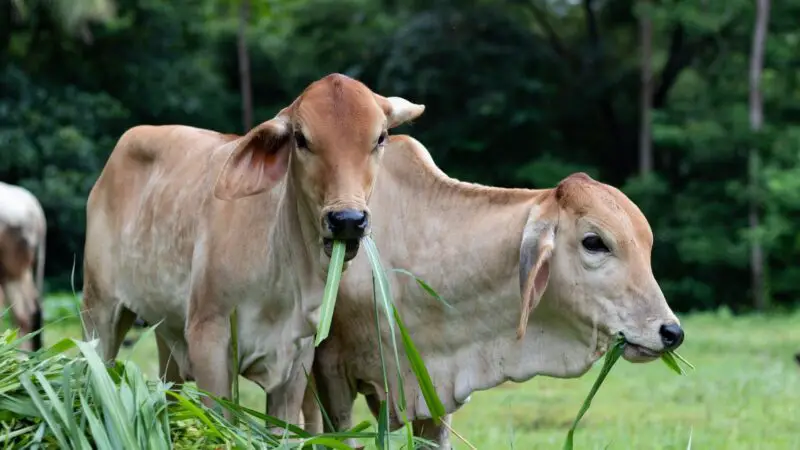
Generally, the bulk of a cow’s diet is grass and a variety of other plant materials, such as grains and weeds. Here’s a more detailed breakdown of what cows eat:
Grass
Cows like eating grass that are 6 inches tall so they can easily snip it without pulling them into their mouths and allow them to focus on arranging the feed into a bolus, referred to as substances that are round-shaped, before swallowing.
Veterinarians found that cows prefer green grass that has 85 to 90 percent moisture content, 15 to 20 percent high in protein, and low in fiber.
Grains
Cows eat a variety of grains, but they primarily eat corn, barley, oats, wheat, and rye.
- Corn. It is typically used as an addition to lower-quality forage-based diets for cows. Also, it is utilized as a main source of grain. It provides cows with rumen-degradable protein and supplementary energy.
- Barley. It contains higher amounts of protein and fiber at a lower cost. It helps improve forage digestion and feed efficiency and increases the daily average gains of grazing cows. It is commonly dry-rolled as it is an inexpensive method and helps cows digest it faster.
- Oats. It is considered the safest grain to feed cows because of fewer obstructions to their digestion. Oats have a high hull and fiber content. Farmers ideally use them for introducing cows to feed before shifting to grains with higher energy content.
- Wheat. Feed-grade wheat is used for the diets of beef cows but not traditionally since its milling properties are better off made for noodles, bread, and pasta. It is fed in moderation since it has lower levels of fiber and a faster rate of starch digestion.
- Rye. This type of grain provides dairy cow farmers and heifer growers an alternative to crops that get destroyed during winter, such as alfalfa. It lowers the total digestible nutrients in feed ration and keeps cows and heifers from getting too fat.
Other Plant Material
Cows can be trained to eat weeds, but some species may be poisonous to them. Cornell University’s Department of Animal Science has put together a list of poisonous weeds to avoid feeding cows.
Other plant matter also includes leftovers such as canola meal, almond hulls, and citrus pulps. Even if these products were thrown away, they’re safe for cows to eat since they can still gain nutrients and energy from them.
Non-Plant Material
Farmers can source candy for their cows from distributors or directly from small plants. They provide fat for cows, and they’re sometimes fed with their wrappers intact. Feeding candy to cows must be limited to a maximum of 5 pounds of candies per day.
Bakery wastes such as expired cookies, stale bread, and other forms of wasted pastry products can also be fed to dairy cows but are usually run through a forage chopper first before feeding and only on a limited amount.
Spoiled sugar beets, pumpkins, pinto beans, potatoes, and oranges can also be fed to cows, according to a range management specialist.
Related: Can Cows Eat Clover? | Is It Good for Them?
How Do Cows Eat?
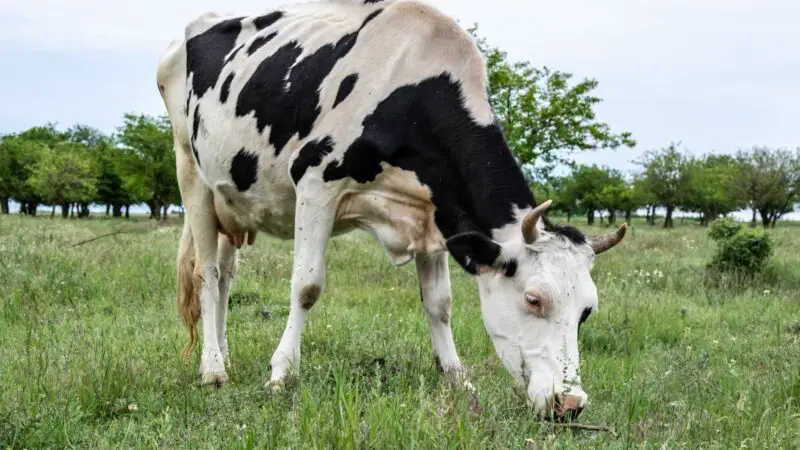
First, cows chew their food enough for them to swallow it. However, there will be unchewed food that will be stored for later chewing and eating.
When eating grass, their tongue will wrap around the grass parts. Then, they pull them using their lower jaw teeth and upper jaw pad and swing their head to sever the grass from its roots.
When cows eat efficiently, they can take up to 80 bites a minute and eat for 8 hours a day. Since cows are ruminants, referring to a group of animals that regurgitate food and re-chew them, it will take 7.5 to 9 hours for rumination.
Understanding a Cow’s Stomach
Cows have four parts in their stomach, which have varying functions depending on what is being digested, namely: the rumen, reticulum, omasum, and abomasum.
- The rumen is the largest part of a cow’s stomach located on its left side and has several sacs. It acts as feed storage capable of holding 25 gallons of material or more. It also serves to ferment feed and absorbs volatile fatty acids.
- The reticulum is a pouch-shaped compartment located near the heart. Feed and other objects that are heavy or dense are dropped here. Even nails and other sharp tools may wind up their way here and cause infections and possibly death if left untreated.
- The omasum is a globe-like part that contains leaf tissues, water, and other feed material and substances from the food cows eat.
- The abomasum is a structure that is lined with glands that release digestive enzymes and hydrochloric acid necessary for the breakdown of feeds.
Unchewed food will travel to the rumen and reticulum, where it will be stored. Cows will then regurgitate the unchewed food and re-chew it, completely this time around, and then swallow. It then goes to the omasum and abomasum for full digestion.
What Do Farm Cows Eat?
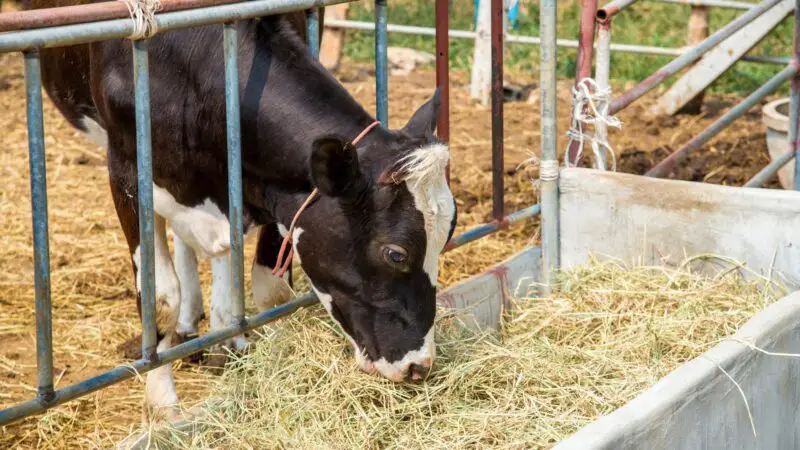
Farm cows should be fed enough forage material such as silage, pasture grasses, legumes, and fodder.
A typical California dairy cow eats 39% byproducts such as soybean meal, almond hulls, and citrus pulp, 36% silages such as alfalfa and ryegrass, 12% grains, 12% hays such as Timothy, and 2% mineral and vitamins that are fed as premixes prescribed by nutritionists.
Formulating cow rations should include decent amounts of dry matter intake, fiber, protein, and non-protein nitrogen, fat, minerals and vitamins, and water, according to experts.
Do Cows Eat Meat?
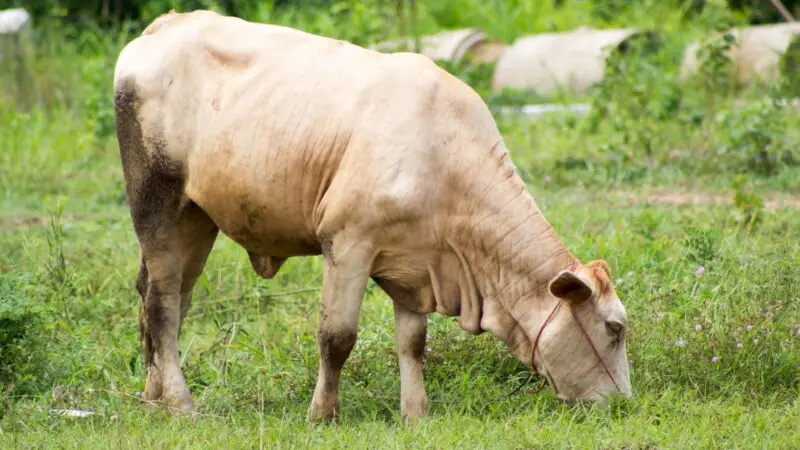
Cows eat meat, but it is rare for them to do so. According to professionals, companies will seldom integrate animal protein in cow feed to provide cows with calcium, protein, and other necessary nutrients.
However, eating meat, specifically those that come from the remains of other bovines, can cause a fatal neural disease in cows called Bovine Spongiform Encephalopathy, otherwise referred to as the Mad Cow Disease.
The US Food and Drug Administration (FDA) has prohibited farmers from feeding cows and other ruminant animals bovine meat since 1997.
Cows’ Abnormal Behavior
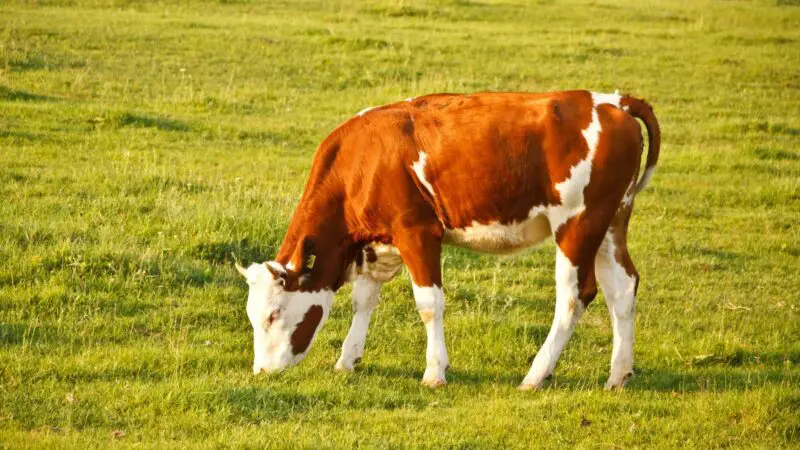
Cows that are infected with BSE will exhibit abnormal behavior, such as having trouble walking, getting up, or standing. They may also act aggressive or agitated, hence why the mad cow disease was coined.
Frequently Asked Questions
Is a Cow a Herbivore?
A cow is a herbivore. They eat a wide variety of plant materials as part of their everyday diet.
Are Cows Becoming Carnivores?
Cows are not becoming carnivores. However, there are rare cases when cows eat other animals, such as live chickens. They typically eat meat to compensate for the lack of protein and other nutrients, but they rarely do so.
Can a Cow Digest Meat?
A cow cannot digest meat. Their digestive systems are biologically designed, through centuries of evolution, to store and digest plant material. They are simply unequipped to digest meat.
Do Cows Eat Humans?
Cows do not eat humans. However, cows are responsible for more than 20 deaths in the United States annually, although the reason is trauma to the chest or head or being trampled upon by cows—but never because they were eaten.
They also couldn’t bite humans as they lack upper front teeth. Even if they have incisors, they’re only located on the lower jaw. As cows grow older, the blunter their teeth become.
What Happens if Herbivores Eat Meat?
Most herbivores aren’t equipped with the appropriate jaw parts and digestive systems to eat and digest meat. However, when they do eat meat, eating too much can cause diseases and even death.
Cows are herbivores that depend on plant materials such as grass, grain, silage, and hay to eat and survive. They also eat non-plant materials such as bakery waste, candy, and spoiled fruits and vegetables.
They have four stomach compartments that are designed for eating and digesting plant material. Hence, they don’t eat meat. Eating meat may be fatal for them.
List of Sources
Cattle Chat: Transitioning to Grass
Weird Things Cattle Eat and It Is Perfectly Ok
